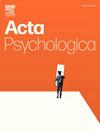The effect of body dysmorphic gazing on body representations: an eye-tracking paradigm
IF 2.1
4区 心理学
Q2 PSYCHOLOGY, EXPERIMENTAL
引用次数: 0
Abstract
Biases in the processing of appearance-relevant stimuli have been proposed to play a role in the etiology and maintenance of body dysmorphic disorder (BDD). Gaze behavior of individuals with BDD shows abnormalities for own and other people's face stimuli, which is expressed in an increased frequency of fixation on perceived flaws. The proposed causal effect on BDD development has yet to be investigated. The aim of the present study is to clarify whether gaze behavior has the potential to causally affect disorder development or body representation at all. To this end, the effect of gaze behavior on the assessment of the attractiveness of one's own face and other people's faces is investigated in a non-BDD sample within an experimental psychopathological approach. In 2 experiments, own and other people's facial photos were to be viewed by N = 44 (Exp. 1) and N = 36 (Exp. 2) participants for several minutes with BDD-typical gaze behavior or freely. Importantly, eye-tracking was used to monitor and maintain the respective gaze behavior by interrupting stimulus presentation as soon as the gaze behavior no longer corresponded to the current strategy (e.g., focus on unattractive area). Forced viewing of unattractive areas led to a decrease in attractiveness judgements in both experiments (Exp. 1: Cohen's d = −0.23, [−0.42, −0.03]; Exp. 2: Cohen's d = −0.35 [−0.67, −0.03]). Free gaze was characterized by a positive processing bias on attractive facial areas (Exp. 1: Cohen's d = 2.06, [1.13, 2.83]; Exp. 2: Cohen's d = 1.40, [0.72, 2.08]). The results support the assumption that gaze behavior directly affects the formation and alteration of body representations and therefore may serve as potential causal risk factor for the development of distorted body representation and eventually clinical conditions like BDD.
身体畸形凝视对身体表征的影响:一个眼动追踪范式
外观相关刺激的加工偏差被认为在身体畸形障碍(BDD)的病因和维持中发挥作用。BDD患者的凝视行为对自己和他人的面部刺激表现出异常,这表现在对感知缺陷的注视频率增加。建议的BDD发展的因果关系还有待调查。本研究的目的是澄清凝视行为是否有可能对障碍发展或身体表征产生因果影响。为此,在一个非bdd样本中,用实验精神病理学方法研究了凝视行为对评估自己和他人面部吸引力的影响。在2个实验中,N = 44(实验1)和N = 36(实验2)的参与者以bdd典型凝视行为或自由凝视的方式观看自己和他人的面部照片几分钟。重要的是,当注视行为不再符合当前策略(例如,关注不吸引人的区域)时,眼动追踪通过中断刺激呈现来监测和维持各自的注视行为。在两个实验中,强迫观看不吸引人的区域会导致吸引力判断的下降(实验1:Cohen’s d = - 0.23, [- 0.42, - 0.03];实验2:Cohen's d = - 0.35[- 0.67, - 0.03])。自由凝视的特征是对有吸引力的面部区域的积极加工偏见(Exp. 1: Cohen’s d = 2.06, [1.13, 2.83];Exp. 2: Cohen’s d = 1.40,[0.72, 2.08])。研究结果支持了凝视行为直接影响身体表征的形成和改变的假设,因此可能是身体表征扭曲发展的潜在因果风险因素,最终导致BDD等临床疾病。
本文章由计算机程序翻译,如有差异,请以英文原文为准。
求助全文
约1分钟内获得全文
求助全文
来源期刊

Acta Psychologica
PSYCHOLOGY, EXPERIMENTAL-
CiteScore
3.00
自引率
5.60%
发文量
274
审稿时长
36 weeks
期刊介绍:
Acta Psychologica publishes original articles and extended reviews on selected books in any area of experimental psychology. The focus of the Journal is on empirical studies and evaluative review articles that increase the theoretical understanding of human capabilities.
 求助内容:
求助内容: 应助结果提醒方式:
应助结果提醒方式:


